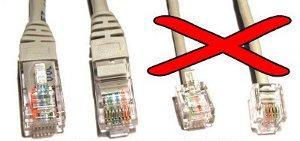Connecting to the network
Connecting to the network in sites with a cabled connection:
- 1. Enable dynamic host configuration protocol (DHCP)
- Dynamic host configuration means that your device requests an IP address from the network. This is called DHCP and is in use in most networks, so in most cases no changes are needed.
- 2. Connect the cable
-
 You will need an eight-pin network cable that has RJ-45 connectors.
You will need an eight-pin network cable that has RJ-45 connectors.
- Note that similar-looking telephone cables must NOT be used! Even though the smaller connector seems it could fit, it might damage the wall socket (see picture).
- A crossover cable cannot be used with all devices.
- In most apartments, there is one network connection per room; when the room has a double outlet, only one of the outlets is connected to the network.
- 3. Done.
- At this point, your computer should automatically request a network address, and your connection should work. If it doesn't check your connections again, and the issues mentioned on the problem report page.
Instructions for use
See the instructions below for other uses and for connecting various devices to the network.
Viruses and malware
F-Secure offers the free Online Scanner for malware removal. For worse cases, where the virus hides itself from the OS, or the OS doesn't boot, you can try the Rescue CD also from F-Secure.
Several free antivirus software are available, for example Avast Antivirus.
Instructions from Microsoft for protecting against malware may also be useful to read. Guides for Windows 7 and Windows 8: [1] and [2].
Network services
| Outgoing email (SMTP) | smtp.lut.fi, smtp.lnet.fi |
| Time server (NTP) | ntp1.funet.fi, fi.pool.ntp.org |
| IRC | irc.lut.fi |
Wireless routers and connecting several devices to the network
You can connect a wireless access point into the network for your own use. Note that the wireless network must be encrypted! The recommended encryption method is WPA2-PSK. Unauthorised users can easily access a network that is not encrypted or uses a weak encryption method (WEP). The owner of the connection will, however, be held responsible for all traffic that passes through the connection. Sharing of the network connection is also forbidden under the Rules of Use. In other words, if the connection is misused, the owner of the network connection can be held liable.
For the same reason, connecting Lnet to systems which specific purpose is to share the network connection with others (such as Fon and Wippies) is forbidden.
See separate instructions on connecting several devices to one connection.
Traffic filtering between Lnet and the rest of the world
Firewall between Lnet and the outside world filters any incoming connections except for traffic coming from the university?s own network. Outgoing traffic is not restricted apart from the following exceptions:
- Sending email to other email servers than Lnet and LUT (smtp.lnet.fi and smtp.lut.fi) is prevented in order to reduce the risk of spam / junk mail.
- Peer-to-peer traffic (p2p) is prevented because their use leads to large traffic volumes, and because most of the data transferred through these applications is illegal distribution of movies, music and other copyrighted materials.
Not all services provided by the university can be accessed from Lnet even when Lnet has not prevented access to them. Home directories at the university can be accessed through portti.lut.fi service.
Traffic volumes are not currently restricted.
Providing services from your own computer (SSH and HTTP)
SSH and HTTP ports for machines in Lnet are available on request. Requests should be sent to the administrators. (Use the problem report form.)